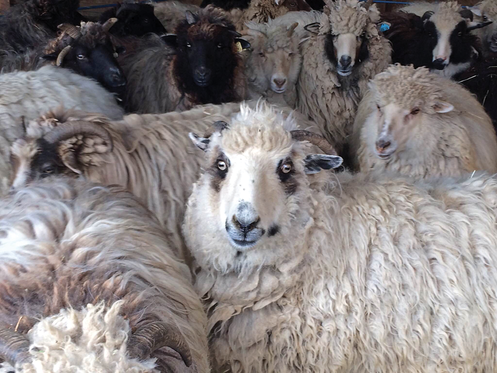Lana Dura
Minna White
Giving Sheep A Job!
How Does It Work? Uniquely Felt by Christine White
Felt is alive, and every wool speaks a slightly different language. This may sound daunting because there are hundreds of types of wool, not to mention other animal fibers. But there is one simple key to unlocking the language: Hold still and listen: In feltmaking, listen means feel. Experienced felters understand this, and beginners, with practice, soon understand that hands and fingers will know what to do.
Many types of animal fibers will felt. In the broader definition of felt as “a sheet of matted or fused material: even things like plant material and man-made fibers might be included. Traditional feltmakers work with wool partly because it is and always has been readily available in many parts of the world. But it also happens that of all the animal fibers, sheep's wool is particularly well suited for entangling, due to the overlapping scales on the surface of the fibers. Many types of fibers have overlapping scales, but it is the well-developed (even exaggerated) texture of wool scales that makes it felt. It helps to understand how fibers move around on a microscopic scale, since these movements often hold the key to why different wools behave in different ways.
Specifically, wool fibers, have an internal, elastic core surrounded by an outer cortex. During the felt making process, the outer part of the fiber softens in response to warm, soapy water and to heat from the friction of fiber-to fiber contacts.This softening allows the whole fiber to behave more dynamically as it moves, releasing some of its stored elastic energy. This results in increased tangling.
When moving thru a pile of wool, fibers will migrate toward their root end, because this is the direction of least resistance. They migrate around the pile and begin to entangle, They can’t move backward – at least very easily.
Once the fibers start holding together many beginning felters will stop felting. To the naked eye, the felt looks coherent, but experienced hands can feel the trapped air pockets and elasticity still present in the fibers. Depending on the felt’s intended use, this might be fine. For a more durable felt that will not stretch, however, it is necessary to keep working the felts to further the process.
Many types of animal fibers will felt. In the broader definition of felt as “a sheet of matted or fused material: even things like plant material and man-made fibers might be included. Traditional feltmakers work with wool partly because it is and always has been readily available in many parts of the world. But it also happens that of all the animal fibers, sheep's wool is particularly well suited for entangling, due to the overlapping scales on the surface of the fibers. Many types of fibers have overlapping scales, but it is the well-developed (even exaggerated) texture of wool scales that makes it felt. It helps to understand how fibers move around on a microscopic scale, since these movements often hold the key to why different wools behave in different ways.
Specifically, wool fibers, have an internal, elastic core surrounded by an outer cortex. During the felt making process, the outer part of the fiber softens in response to warm, soapy water and to heat from the friction of fiber-to fiber contacts.This softening allows the whole fiber to behave more dynamically as it moves, releasing some of its stored elastic energy. This results in increased tangling.
When moving thru a pile of wool, fibers will migrate toward their root end, because this is the direction of least resistance. They migrate around the pile and begin to entangle, They can’t move backward – at least very easily.
Once the fibers start holding together many beginning felters will stop felting. To the naked eye, the felt looks coherent, but experienced hands can feel the trapped air pockets and elasticity still present in the fibers. Depending on the felt’s intended use, this might be fine. For a more durable felt that will not stretch, however, it is necessary to keep working the felts to further the process.
*******


